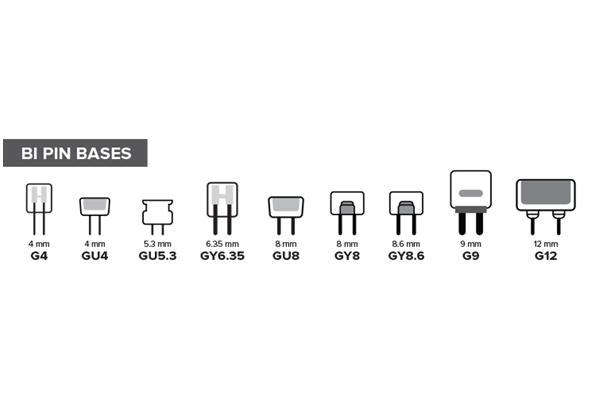When you are out to buy a new bulb and you have no idea which fitting it is you need, you might as well go home. This is why you need to understand the differences between fittings and the choices available to you especially when it comes to bi-pin bases.
What is Bi-Pin Fitting?
Bi-pin or Bipin is sometimes referred to as bi-pin cap, bi-pin socket, or two-pin. This is a type of lamp fitting, which is included in the IEC standard. These fittings are often used on small incandescent light bulbs, particularly halogen lamps.
Sockets can have pins placed closer together to help prevent the insertion of bulbs that consume a lot of electricity as this can generate excessive heat, which may possibly cause a fire. Bi-pins were invented by Reginald Fessenden for the 1893 World’s Fair in Chicago, but it was Westinghouse that developed the bi-pin base to use at the fair.
Bi-pins fittings are usually represented by the capital letter G followed by a number or mixture of numbers and letters. G refers to the plugin lamp, while the numbers after G refers to the distance between the pins’ center point.
Different Kinds of 2 Pin Fittings and their Uses
G4 Fitting

Throughout the years, numerous technical developments have been geared toward improving G4 fitting. Before, you’d only find the G4 halogen light bulbs. Nowadays, you’d find G4 fittings for LED bulbs, which are even energy-friendly than halogen lamps.
G4 fittings are suitable for 12v lighting. A pin fitting of two pins per pin socket characterizes G4 fittings. This is why it’s referred to as bi-pin fittings. The number 4 in G4 represents the distance between the two pins, and the distance is exactly 4 millimeters.
G4 fitting lights are used in campers, boats, mobile phones, and cars. You can also find a wide range of 12-volt lights suitable for G4 fittings.
A G4 bulb is quite similar to the GU5.3 fitting. They both have two pins that are thin and small; however, the G4 is typically used for decorative and atmospheric lighting. G4 fittings are usually found in lamps, pendant lights, floor lamps. They are usually 12V connections, and they often require a transformer to work.
GU4 Fitting

This is a smaller version of the GU5.3. Like the GU5.3, the GU4 has a bi-pin fitting, and it requires 12v low voltage. It is used in MR11 and MR8
GU5.3

This bi-pin fitting features two metal pins, which can conduct electricity. The distance between the pins in a GU5.3 fitting is 5.3 mm. Typically, a GU5.3 operates using 12 volts. Voltages vary across all bulbs, so make sure to check the specifications to ensure that your fixture, fitting, and voltage are all compatible. There is a GZ5.3 version of the GU5.3 fitting, but a GZ5.3 won’t fit in the GU5.3 fitting, so again make sure to check before you buy your fitting.
G5.3

This fitting is very similar to the above GU5.3 fitting except the pin diameter is a tad smaller
GY6.35

The GY6.35 fitting is typically used in low voltage display applications. It is used commonly in residential lamps, desk lamps, hanging lights, and effect lighting. This fitting is also used in the field of medicine, entertainment, and science. You would find this fitting in a microscope, ophthalmic machines, microfilm, and projector. It is small, but it can be quite effective.
G8, GY8, and GY8.6

A G8 fitting means that there is a space of 8 mm between the two pins. This is used in 120 volts bulb. Both G8 and GY8 fittings are bi-in fittings. The difference between them is the length of the pin. While the pin length of G8 fitting is 8 mm, GY8 has a pin of 8.5 mm. The thickness of the pins for both types of the fitting is the same. The pins measure 1 mm. For most applications for these fittings, the pin length will not make a difference, and you can use either of the fittings.
G9

G9 fittings are characterized by 2 long pins that connect to the lamp. These fittings are usually seen in smaller lighting like those used in walls or ceilings. These fittings have small connection points. The distance between these two pins is 9 mm. They can be slotted easily into place without needing to do anything else. The pins are straight or looped, and they usually come with 120 volts.
These are the most common 2-pin fittings. It is important to familiarize yourself with these fittings, so you will be able to use the right type of lighting for your home, office, or business.
GU10

These are generally used for reflector spot lighting bulbs. These also have thicker 5MM pins to hold the heavier weight of a down spot light. GU10 requires a gentle twist after plugging in for it to lock into position.


5 comments
Can you covert a GU5.3 base to a GU 4 using an adapter?
I have some G4 pin bulbs that need replacing in my under cabinet lighting. I ordered some fro. Another site and the pins are thinner and won’t stay in the holes. Are there G4 bulbs with a thicker diameter in the pin?
I have a 3 pendant dining room light fixture. It has a 120v to 12volt 150 watt transformer operating (3) 50watt 12volt GY3.65 halogen bulbs, totalling 150 watts.
It worked great for many years but the transformer blew out 2 years ago and again 2 weeks ago.
What am I doing wrong?
Also, I can’t find LED 45w or 50w -equivalent bulbs with the GY6.35 prongs, to reduce the wattage draw.
Suggestions?
Randy Miller
Do you have the gu10 to use in an overhead light fixture.
They are about 4 or 5 inches long
Your section on G8, GY8, GY8.6 does not describe the GY8.6 variant. Please revise. Thanks.